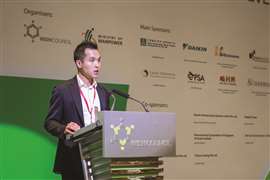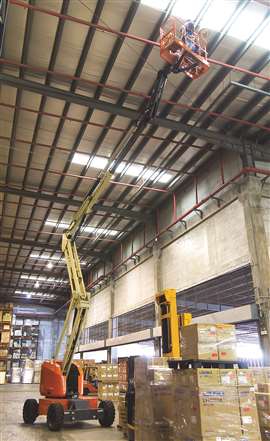Singapore’s access rental market: saturation and price wars
25 November 2024
Shawn Ong, COO of Singapore’s largest rental company Galmon, explains the tactics required in a saturated market with a tough economy
Galmon is the largest rental company in Singapore, now celebrating its 42nd year of operation in one of the world’s most established and mature MEWP markets, yet the company is grabbling with two major issues - a downturn in the access sector and low availability of labour.
 Shawn Ong, COO of Galmon.
Shawn Ong, COO of Galmon.
As Shawn Ong, Galmon’s Chief Operating Officer says, the market is “saturated” and subject to a “price war”.
Galmon specializes in aerial platforms, with a fleet of around 2,500 units. The company has a long partnership with JLG, which has traditionally supplied a majority of its equipment.
As a distributor, Galmon also sells telehandlers, although their use in Singapore is minimal, with only 10 to 20 units registered for use in the country. Most of its sales for telehandlers are found outside Singapore in Indonesia, Malaysia and other parts of Southeast Asia, where it offers Magni and some Chinese brands.
Having said that the market for telehandlers anywhere in Asia is very small, as it remains a predominantly US and European product.
Equipment mix
When it comes to MEWPs, Galmon distributes equipment outside Singapore. Ong says, “with China manufacturers on the rise, we do now bring in brands such as Dingli and Zoomlion.

“Our main bulk is still JLG, but when it comes to new equipment we would generally purchase Chinese brands due to lower cost, as in Asia generally, and Southeast Asia price is very sensitive - the price war is tremendous in the region.
“We have to use the Chinese brands to be price competitive in the market.
The company has established sales in Malaysia and Thailand, with the latter country, “being quite consistent – there has not been a spike or a drop in the last two years”.
Malaysia, on the other hand, has experienced a downturn in projects for MEWPs, says Ong. (see the article with Aerial Global’s Alex Tan, who is based in the country). “After the first quarter this year there was a drop in demand due to the end of major projects.” This includes the Exchange TRX shopping centre and the Merdeka 118 skyscraper refurbishment project in centrally-located Kuala Lumpur, along with Intel projects in Penang to the north of the country.
Vietnam and Indonesia, another important two access markets in Southeast Asia have also been quiet since the pandemic, says Ong, “But for us it is difficult to sell in Indonesia because of the cultural differences.”
Apart from that, Galmon also sells a handful of units to Cambodia and Laus.
There are 11,000 – 12,000 lifts registered in Singapore, according to Ong, which has been constant over the last 10 years. “We will not see any more growth in Singapore,” says Ong. “It is saturated.”
The ministry of manpower sates that all access platforms must be registered for use.
Market investment
There are around 70 rental companies in the country, including the largest such as Aver Asi and Modern, but unlike in other growing Southeast Asian nations, Singapore is unlikely to see foreign rental firms establishing themselves there.
 A Dingli boom provided by Galmon.
A Dingli boom provided by Galmon.
“Chinese companies wanted to come here a couple of years ago but they decided not to and move into Malaysia instead, as growth prospects are much higher.
“Malaysia has put a fair amount of resources into developing the country, including into a data centre hub and updating their infrastructure, like their MRT train project. So, prospects there are much higher, and they are trying to woo foreign investors and investing in infrastructure to accommodate them.
“That growth has been happening for the two years before Covid – until now.”
Thailand, says Ong has changed government - the military took over and after that there hasn’t been much growth. Its stable but for political reasons there is not a huge rise in construction projects.
Indonesia is undergoing similar experience with government instability, “making investors very cautious – no one wants to make a big move there at the moment.”
“Malaysia is seeing more potential.”
Likewise, at home Galmon is not seeking huge growth. “After Covid we had two issues,” says Ong.
“There’s not many big projects so it’s pretty quiet, then there’s the labour issue. The government is restricting foreign labour, hence it is difficult for Singapore companies to find it.
“Our industry requires manual labour to service equipment and Singaporeans do not want to work in these jobs so we rely on foreign labour.”
Ong adds that since Covid, and following the government restrictions which were brought in about a year before Covid, the labour force has shrunk by 15%.
Many returned to their home countries during the pandemic, and now getting new permits for them to return is more difficult than before.
There are 150 employees at Galmon but that’s 15% less than two years ago.
In response companies like Galmon are shifting further into telematics and IoT to replace the workforce, but that, says Ong, can only solve around 20% of the problem.
“At the end of the day we still require labour and our customers have to bear the brunt of waiting longer for their equipment to be serviced – they are looking at longer turnaround times.”
Economy focus
The economy in Singapore is down too in 2024, versus 2023. “Everyone is now looking at three big projects.”
 One of Galmon’s large flett of JLGs.
One of Galmon’s large flett of JLGs.
Those being the expansion of the Resort World Casino, the Marina Bay casino and the new terminal five Changi Airport. All three are waiting for the go ahead, and while its just a matter of time before they start, MEWPs will not enter until the second half of the project, which leaves Galmon with an even longer waiting period.
It means, Ong believes, that the access sector in the country will not see a spike in growth until the second half of 2025.
Reflecting this Galmon’s utilization rate currently stands at 60%, compared to the norm of around 80%. “Again, this is due to the market being flat and the labour issue.”
Rental rates are pretty low too, “because everyone is trying to push their equipment out into a low market.”
For example, a 6m scissor is finding rental rates of S$300 a month. That’s half the amount the same piece of equipment was getting last year. “There is a price war out there,” Ong reiterates.
In comparison, Malaysia is commanding a higher rate but the country is suffering from payment issues, which means the company is waiting around 180 days for payment compared to 60 days in Singapore. “So, there are pros and cons in both countries,” says Ong.
What percentage of Galmon’s fleet is bought new? Ong answers, “If you look at a single year’s purchase of equipment, it is about 30% new and 70% used. That percentage is not really changing.
“Generally, our purchase of western equipment has gone down in the last three to four years. In the past it was JLG but in recent years it has gone down and percentage wise is now 60-70%.”
When it comes to used equipment the company still invests in western brands, such as JLG or Genie.
Booms on the rise
One area of the market in Singapore that is seeing growth is for large scissors and boom lifts.
“With the market being mature we see the requirements for smaller equipment is much lower but the demand for larger equipment is actually on the rise – and the preference is for electric, for more flexible use.”
As such the company is investing in this area. So far Galmon’s largest boom is 28m and they have an 18m scissor. “We will invest in bigger equipment in the future - we are constantly on the look out for larger electric booms and scissors for the market.”
Currently the total percentage of scissors to booms in Singapore is 60/40 in favour of scissors, says Ong.
But beyond scissors and booms, the population of specialist equipment is small. For example, the company only has five spider lifts out for rental in the country, and that is not likely to change. “Demand is generally low and customers require an operator. As labour is short we are not able to provide operators.”
The labour issue doesn’t end there for spiders. “Spiders are often used in shopping malls and airports in the middle of the night. We try not to provide a 24-hour service, because if your labour works during the night, the next day we will have a shortage of manpower.”
When the company does sell spiders into the domestic market, it tends to be four or five a year from its partners Platform Basket and Falcon. “The spider market is constant – the annual sales has been the same for about 20 years.”





